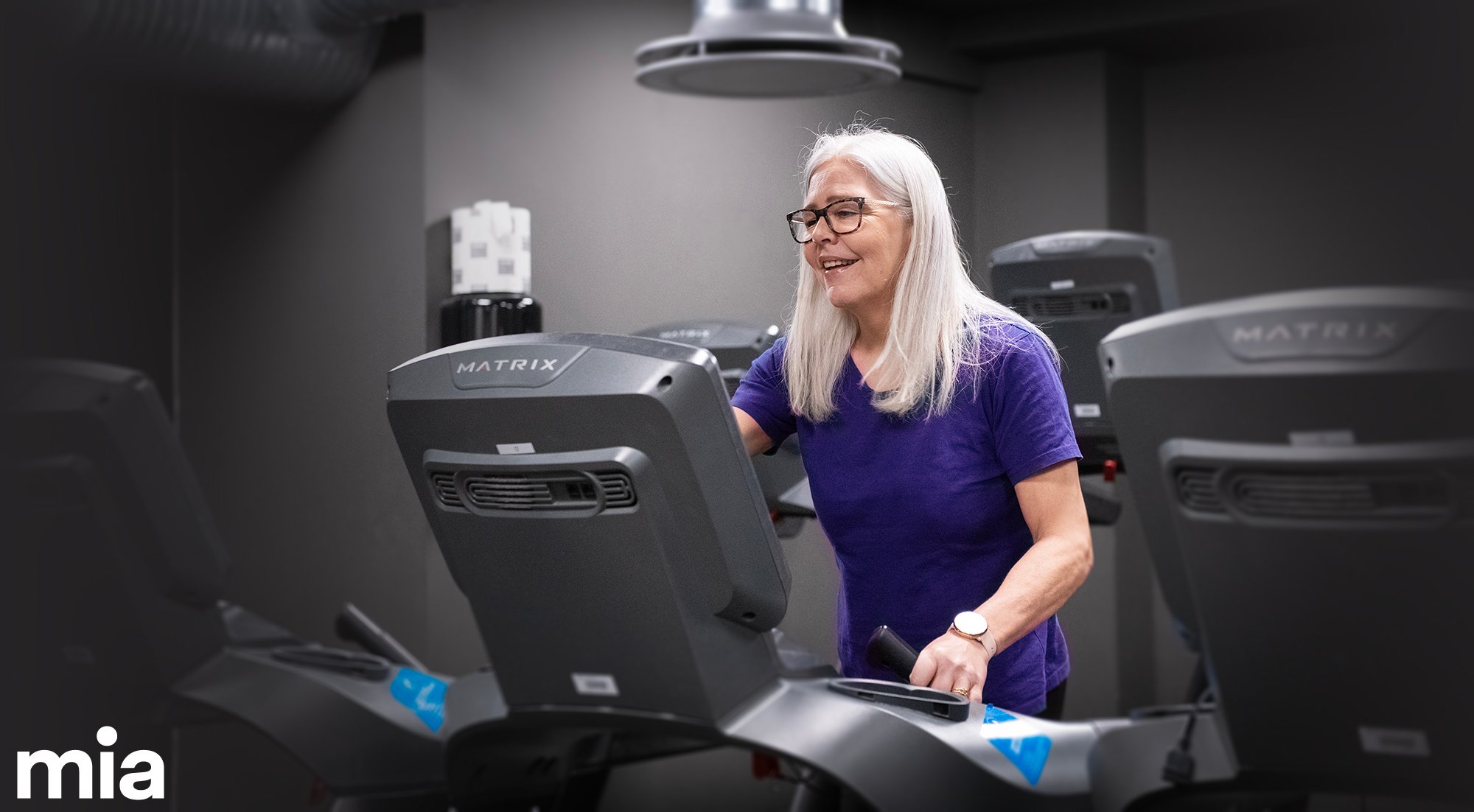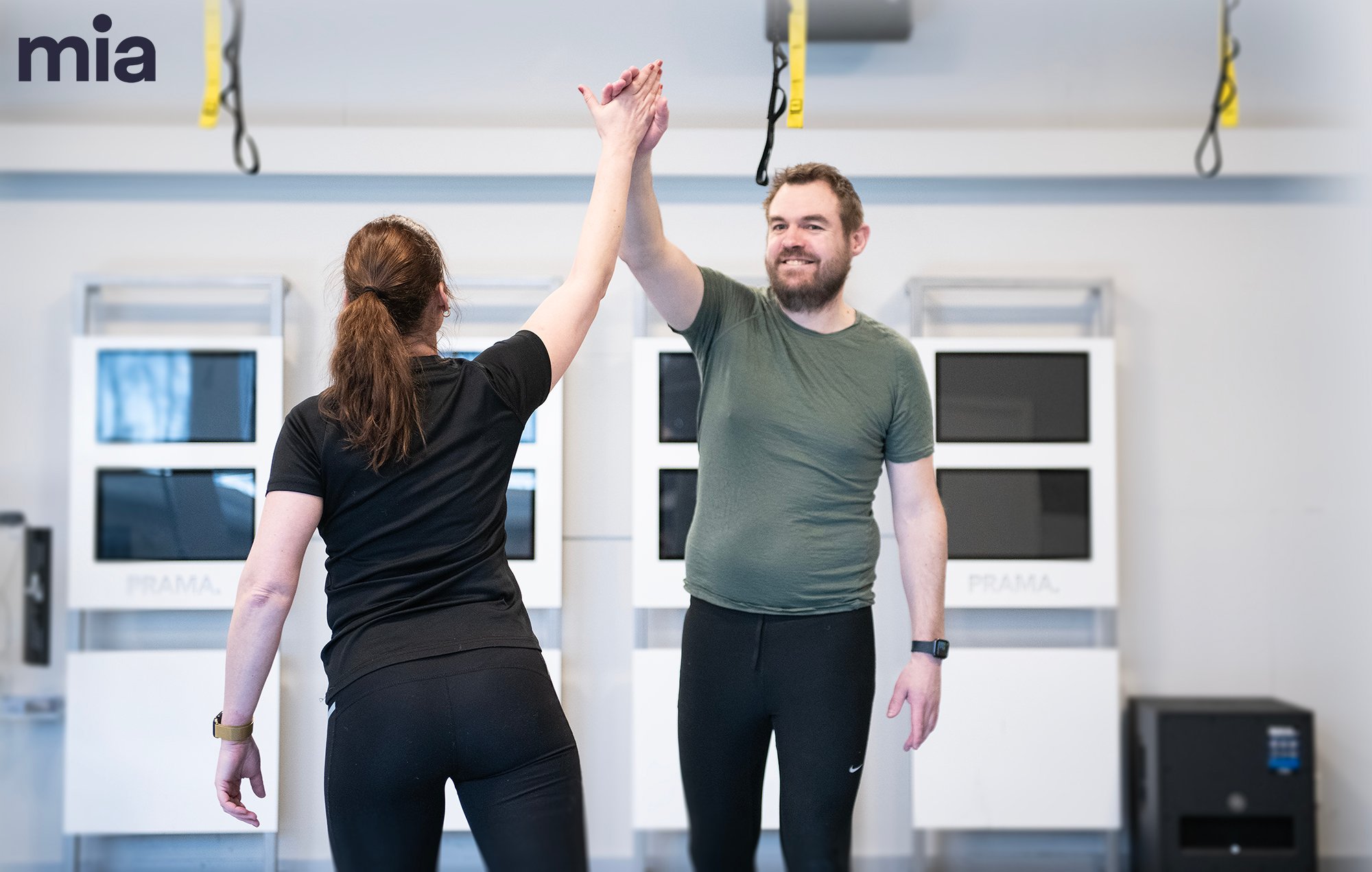Lower your fitness age and get younger than your body
Your fitness level says more about your health than your smoking habits, blood pressure, body weight and blood sugar. With Mia Health, you can easily exercise your way to a higher fitness level and achieve a fitness age that makes you younger than your birth certificate.
The most accurate measure of physical fitness is maximum oxygen uptake - VO2 max. If you have a high maximum oxygen uptake, you will run the 10 km faster than a person with a low maximum oxygen uptake (1, 2, 3).
But VO2 max doesn't just determine performance in endurance competitions. The higher your maximum oxygen uptake, the lower your risk of poor health today (4). And of having poor health in the future (5).
VO2 max is expressed as a number - the fitness number. Bjørn Dæhlie had a fitness number of 96. For a seriously ill heart patient, the number can be lower than 10 (6).
And your fitness level? The Mia Health app easily calculates it for you. How it does that? We'll come back to that in a moment.

From fitness numbers to fitness age
There is a more understandable way to describe this. That's why we first want to introduce you to the concept of fitness age.
If your fitness level is high, you have a low fitness age. A well-trained 70-year-old, for example, can have a fitness level as high as an average 45-year-old.
Thus, her fitness age is 45 years.
Similarly, your fitness age can increase much faster than your real age if you move little. There are many examples of 30-40-year-olds whose fitness age is several decades older than themselves.
Lower your fitness age with exercise
As you've probably realized already, this all means that you should exercise in a way that improves your fitness and lowers your own fitness age. Regardless of whether your goal is to set a new record on your regular run or to increase your chances of healthy aging - or, perhaps preferably, both.
Luckily, Mia Health's precise fitness age calculation - together with our motivating AQ tool - is all you need to exercise yourself many years younger than your body.
If you achieve 50 AQ or more every week, your fitness age will slowly but surely decrease towards your actual age (7). 50-100 AQ will also help you maintain a low fitness age if you are already fitter than average for your age.

The story of VO2 max
We've known for a long time that there are many benefits to having a low fitness age, i.e. a high maximum oxygen uptake for your age. But the last few decades have shown us that it's probably even more important than most people have thought.
Better performance
Almost exactly 100 years ago, Archibald Hill became the first person to describe maximum oxygen uptake (8).
Hill explained that each of us has an upper limit of oxygen uptake and that this limit defines how well we can perform in an endurance competition (9). After that, endurance athletes began to focus on exercise that increases their fitness levels.
They still do that today.
But it took a Norwegian to prove that fitness levels are about much more than getting from A to B as quickly as possible: Jan Erikssen from Oslo.
Better health
In the early 1980s, Eriksen's research group tested the fitness levels of over 2,000 healthy middle-aged and older men, including a large group of former cross-country skiers. The study showed a clear link between high fitness and a reduced risk of dying over the next seven years (10).
In many ways, this was the first study to link better fitness to better health. Since then, there have been a myriad of similar research articles, all suggesting the same:
If you are fit compared to others your age, you can expect that everyday activities will feel easier (11), to live longer (12) and to avoid lifestyle diseases such as heart attacks (13), diabetes (14) and cancer (15).

Why your fitness level is so important
Perhaps the next question is why your maximum oxygen uptake is so important for your health. It is in fact even more important than known risk factors such as smoking habits, blood pressure, body weight and cholesterol levels (16).
Actually, it's quite straightforward: Without oxygen, it would be impossible to live on Earth. Absolutely every cell in our body needs oxygen to function. The more oxygen the body is able to absorb and utilize to produce energy, the better equipped we are.
A maximum oxygen uptake test can quantify just that: How much oxygen your body is able to absorb and utilize for muscle work every minute at maximum exertion. The result is expressed in the number of milliliters of O2 per kilogram of body weight per minute: ml/kg/min.
This is the fitness number we've already mentioned so many times.
From air to heart
And the fitness number - our maximum oxygen uptake - tells us something about the state of many important parts of our body.
Take the lungs, for example. The oxygen that eventually ends up in our muscles starts its journey in the air that we breath in. The job of the lungs is to transfer the oxygen to the bloodstream. High oxygen uptake requires healthy and strong lungs that breathe well.
But healthy lungs are of little use if the heart is weak. Once the lungs have delivered oxygen to the blood vessels in the pulmonary circulation, the oxygen-rich blood is transported to the heart, which is responsible for pumping it to the rest of the body. A high oxygen uptake requires a strong and resilient heart that can pump large amounts of blood with every beat.

From heart to muscle
Blood vessels transport oxygen from the heart to the muscles. A high oxygen uptake requires that the oxygen is not slowed down more than necessary on the way there. This requires blood vessels with a good ability to expand.
And when the oxygen reaches the muscles, it is absorbed by the muscle cells and contributes to the energy production that enables us to move. High oxygen uptake requires a dense network of small blood vessels around the muscles, as well as muscles that have both a good ability to pick up oxygen from the blood and an efficient system for producing as much energy as possible using the oxygen.
All of this is interconnected. If you have a disease or impairment in just one of the links in this chain, the maximum oxygen uptake decreases.
So it's perhaps not surprising that your VO2 max tells you so much about your health, both now and in the future. Fortunately, effective endurance training can repair many of these deficiencies, increase oxygen uptake and improve your health (17).
How to find your fitness number
Now, you would probably like to know your own fitness level, and how the Mia Health app can calculate your exact fitness age?
Accurate, but demanding
Let's get the bad news out of the way before we get to the good news: Performing a completely accurate VO2 max test requires expensive equipment, trained personnel and a high level of motivation.
You've probably seen such a test on TV or the internet. An increasingly exhausted man wearing a face mask is running steeply uphill until he simply can't take any more.
Tempting for some, perhaps, but not at all for everyone.
The first piece of good news is that you don't have to perform such a test. Because several thousand people in Trøndelag, Norway have done it for you. The results of their measurements allow us at Mia Health to easily calculate your fitness age based on who you are and how you exercise.
And as we will soon show you: We can guarantee that the fitness age we give you is accurate enough to reveal a lot about your health.
How high should your fitness level be?
Let's go back to the people of Trøndelag, Norway. Between 2006 and 2008, 4,600 of them took part in the world's largest project to date on accurate fitness testing, conducted by the Cardiac Exercise Research Group (CERG) at the Norwegian University of Science and Technology (NTNU).
This gave the world its first overview of the average fitness level for people in all age groups from 20 to 90 years (18). In the table below you can find the average fitness number for your age category.
|
Age group |
Females |
Males |
|
20-29 years old |
43 |
54 |
|
30-39 years old |
40 |
49 |
|
40-49 years old |
38 |
47 |
|
50-59 years |
34 |
42 |
|
60-69 years |
31 |
39 |
|
Over 70 years |
27 |
34 |
Find your fitness age from the couch
In addition to the precise fitness test, the researchers measured blood pressure, weight and a number of other health variables in the same Trøndelag residents. The participants also answered hundreds of questions about their own lifestyle and health.
In this way, the NTNU researchers were not only able to determine the expected fitness level for all ages, but also which factors have the greatest impact on this fitness level (19).
This enabled them to develop the Fitness Calculator, which calculates your fitness based on your age, resting heart rate, body mass index and how much and how hard you exercise in your leisure time.
And so everyone could find their fitness age from their own couch by filling in a simple form. Slightly less accurate than running with a mask until you can't take it anymore, but oh so much more comfortable!
Active fitness age with Mia Health
Mia Health has further developed the fitness formula from NTNU. Our model combines the best of their Fitness Calculator with your actual exercise habits.
Because where NTNU has relied on self-reported physical activity data at a single point in time, we use your heart rate data to look at the actual physical activity you do - and how your activity level changes over time.
In the Mia Health app, you can therefore track your fitness age on an ongoing basis, see how it has developed since you started using the app, and how it will develop in the weeks to come.
This makes it easy to plan your training for the future. If your fitness age is decreasing, you're on the right track. But if the trend shows an increasing fitness age, you should probably add some more effective workouts in the time to come.
We know that it will help both your fitness and your health. Read on and you'll see why.

Health in every fitness year
Since 2013, NTNU's Fitness Calculator has been tested by almost 10 million people. And it's not without reason.
The calculator doesn't just give you a good estimate of your fitness age. Like more accurate measurements of VO2 max, it also tells you a lot about the state of your health.
In fact, the calculator is such a good measure of health that the Norwegian Directorate of Health encourages you to use it and has created a user-friendly version on its website. And the US health authorities recommend the calculator for doctors who want to map the fitness of their patients (20).
Longer life
The reason for the generous recommendations is a number of research articles published by CERG in recent years. The studies, which are based on data from more than 70,000 Norwegian women and men, look at the relationship between the results of the Fitness Calculator and health in both the present and the future.
First, the researchers calculated the fitness of almost 40,000 healthy people who participated in a health survey in the 1980s. In both men and women over and under the age of 60, the higher the fitness level, the lower the risk of dying from cardiovascular disease over the next 25 years (21).
For example, if you had average or better fitness for your age, you had up to half the risk compared to those who had a fitness level of 85% or lower than expected for their age (21).
In other words: Lowering your fitness age increases the likelihood of a long and healthy life.
Today's heart health
People with a higher fitness age than their own age are more likely to have many risk factors that make them susceptible to cardiovascular disease in the future. In fact, the likelihood of having at least three such risk factors is multiplied compared to their peers of lower fitness age. The risk is particularly high for those who are both unfit and sit still a lot during the day (22).
On the other hand, you can sit with a clear conscience if the fitness age measurements show that you are in good shape for your age. Men and women who sit for at least seven hours every day, but still score high on the Fitness Calculator, do not have any more risk factors than those who are both sedentary and fit (22).

Future heart disease and cancer
Researchers have also shown that the risk of heart attack and cancer decreases in line with higher fitness levels. For example, the risk of having a heart attack is reduced by up to 25% for women whose fitness age is younger than their actual age (23), while the third of women with the lowest fitness age have a 15% reduced risk of cancer (24).
In addition, fitness age can provide an indication of who is at increased risk of having to undergo heart surgery in the future (25, 26). People who have undergone heart surgery also live longer if their fitness age is low before surgery (25, 26).
Atrial fibrillation also appears to be preventable with exercise that lowers fitness age. In a study with more than 40,000 participants, there were fewer cases of atrial fibrillation among those who were initially fit, but also among those who improved their fitness over time (27).
In another article, the researchers show that low fitness age is also linked to a reduced risk of premature death if you already have atrial fibrillation. The 25% with the best fitness for their age had a nearly 40% lower risk of dying during the follow-up period, compared with those with poor fitness (28).
Depression, dementia and fatty liver
People who maintain a low fitness age over time also have half the risk of developing dementia. And just as importantly: By increasing your activity level and lowering your fitness age closer to your actual age, you can expect almost the same risk reduction (29).
In addition, the researchers found greater brain volume in middle-aged men and women who exercised their way from a high to a low fitness age over a ten-year period, compared with their peers who did not lower their fitness age (30). Good fitness is also linked to a significantly reduced risk of dying from or with dementia (29).
People with a significantly higher fitness age than their actual age are also many times more likely to have fatty liver disease. And if you have fatty liver disease and a high fitness age, the risk of dying young is significantly higher than if you have fatty liver disease and a low fitness age (31).
Furthermore, research shows that people with a fitness age of average or below are less likely to be depressed. High fitness age is also associated with an increased risk of developing depression over the next ten years (32). Another study shows that depressed people with a high fitness age live shorter lives than others (33).

Forever young with Mia Health
All in all, there are many reasons why it's useful to know your own fitness age. It tells you how fit you are, but it also says a lot about the health of your brain, heart and the rest of your body.
With a lower fitness age, you increase your chances of staying healthy and fit for many years. Mia Health simply gives you the answer to how old your body is.
The fitness age in the app doesn't lie. On the contrary, it can motivate you to stay young for the rest of your life.
Reference list:
- Foster, C. (1983). V O2 max and training indices as determinants of competitive running performance. Journal of Sports Sciences, 1(1), 13-22.
- Ramsbottom, R., Nute, M. G., & Williams, C. (1987). Determinants of five kilometer running performance in active men and women. British journal of sports medicine, 21(2), 9-13.
- Butts, N. K., Henry, B. A., & McLean, D. (1991). Correlations between VO2max and performance times of recreational triathletes. The Journal of sports medicine and physical fitness, 31(3), 339-344.
- Aspenes, S. T., Nilsen, T. I., Skaug, E. A., Bertheussen, G. F., Ellingsen, Ø., Vatten, L., & Wisløff, U. (2011). Peak oxygen uptake and cardiovascular risk factors in 4631 healthy women and men. Medicine and science in sports and exercise, 43(8), 1465-1473.
- Kodama, S., Saito, K., Tanaka, S., Maki, M., Yachi, Y., Asumi, M., Sugawara, A., Totsuka, K., Shimona, H., Ohasi, Y., Yamada, N., & Sone, H. (2009). Cardiorespiratory fitness as a quantitative predictor of all-cause mortality and cardiovascular events in healthy men and women: a meta-analysis. Jama, 301(19), 2024-2035.
- Corrà, U., Giordano, A., Mezzani, A., Pistono, M., Gnemmi, M., Kamiya, K., & Giannuzzi, P. (2013). Prognostic significance of peak oxygen consumption≤ 10 ml/kg/min in heart failure: context vs. criteria. International journal of cardiology, 168(4), 3419-3423.
- Nauman, J., Nes, B. M., Zisko, N., Revdal, A., Myers, J., Kaminsky, L. A., & Wisløff, U. (2019). Personal activity intelligence (PAI): a new standard in activity tracking for obtaining a healthy cardiorespiratory fitness level and low cardiovascular risk. Progress in cardiovascular diseases, 62(2), 179-185.
- Hill, A. V., & Lupton, H. (1923). Muscular exercise, lactic acid, and the supply and utilization of oxygen. QJM: An International Journal of Medicine, (62), 135-171.
- Hale, T. (2008). History of developments in sport and exercise physiology: AV Hill, maximal oxygen uptake, and oxygen debt. Journal of sports sciences, 26(4), 365-400.
- Lie, H., Mundal, R., & Erikssen, J. (1985). Coronary risk factors and incidence of coronary death in relation to physical fitness. Seven-year follow-up study of middle-aged and elderly men. European heart journal, 6(2), 147-157.
- History of developments in sport and exercise physiology: AV Hill, maximal oxygen uptake, and oxygen debt. Journal of sports sciences, 26(4), 365-400.
- Lie, H., Mundal, R., & Erikssen, J. (1985). Coronary risk factors and incidence of coronary death in relation to physical fitness. Seven-year follow-up study of middle-aged and elderly men. European heart journal, 6(2), 147-157.
- Sloan, R. A., Sawada, S. S., Martin, C. K., Church, T., & Blair, S. N. (2009). Associations between cardiorespiratory fitness and health-related quality of life. Health and Quality of Life Outcomes, 7(1), 1-5.
- Imboden, M. T., Harber, M. P., Whaley, M. H., Finch, W. H., Bishop, D. L., & Kaminsky, L. A. (2018). Cardiorespiratory fitness and mortality in healthy men and women. Journal of the American college of cardiology, 72(19), 2283-2292.
- Letnes, J. M., Dalen, H., Vesterbekkmo, E. K., Wisløff, U., & Nes, B. M. (2019). Peak oxygen uptake and incident coronary heart disease in a healthy population: the HUNT Fitness Study. European heart journal, 40(20), 1633-1639.
- Zaccardi, F., O'Donovan, G., Webb, D. R., Yates, T., Kurl, S., Khunti, K., Davies, M. J., & Laukkanen, J. A. (2015). Cardiorespiratory fitness and risk of type 2 diabetes mellitus: A 23-year cohort study and a meta-analysis of prospective studies. Atherosclerosis, 243(1), 131-137.
- Schmid, D., & Leitzmann, M. F. (2015). Cardiorespiratory fitness as predictor of cancer mortality: a systematic review and meta-analysis. Annals of oncology, 26(2), 272-278.
- Myers, J., Prakash, M., Froelicher, V., Do, D., Partington, S., & Atwood, J. E. (2002). Exercise capacity and mortality among men referred for exercise testing. New England journal of medicine, 346(11), 793-801.
- Kemi, O. J., & Wisløff, U. (2010). High-intensity aerobic exercise training improves the heart in health and disease. Journal of cardiopulmonary rehabilitation and prevention, 30(1), 2-11.
- Loe, H., Rognmo, Ø., Saltin, B., & Wisløff, U. (2013). Aerobic capacity reference data in 3816 healthy men and women 20-90 years. PloS one, 8(5), e64319.
- Nes, B. M., Janszky, I., Vatten, L. J., Nilsen, T. I., Aspenes, S. T., & Wisloff, U. (2011). Estimating VO 2peak from a nonexercise prediction model: the HUNT Study, Norwayi. Med Sci Sports Exerc, 43(11), 2024-30.
- Ross, R., Blair, S. N., Arena, R., Church, T. S., Després, J. P., Franklin, B. A., Haskell, W. L., Kaminsky, L. A., Levine, B. D., Lavie, C. J., Myers, J., Niebauer, J., Sallis, R., Sawada, S. S., Sui, X., & Wisløff, U. (2016). Importance of assessing cardiorespiratory fitness in clinical practice: a case for fitness as a clinical vital sign: a scientific statement from the American Heart Association. Circulation, 134(24), e653-e699.
- Nes, B. M., Vatten, L. J., Nauman, J., Janszky, I., & Wisløff, U. (2014). A simple nonexercise model of cardiorespiratory fitness predicts long-term mortality. Medicine and science in sports and exercise, 46(6), 1159-1165.
- Nauman, J., Stensvold, D., Coombes, J. S., & Wisløff, U. L. R. I. K. (2016). Cardiorespiratory fitness, sedentary time, and cardiovascular risk factor clustering. Medicine and science in sports and exercise, 48(4), 625-632.
- Shigdel, R., Dalen, H., Sui, X., Lavie, C. J., Wisløff, U., & Ernstsen, L. (2019). Cardiorespiratory fitness and the risk of first acute myocardial infarction: the HUNT study. Journal of the American Heart Association, 8(9), e010293.
- Wang, J., Mai, X. M., & Sun, Y. Q. (2023). Estimated cardiorespiratory fitness in relation to overall, breast and prostate cancer incidence: the Norwegian HUNT study. Annals of Epidemiology, 77, 103-109.
- Smenes, B. T., Nes, B. M., Letnes, J. M., Slagsvold, K. H., Wisløff, U., & Wahba, A. (2022). Cardiorespiratory fitness and the incidence of coronary surgery and postoperative mortality: the HUNT study. European Journal of Cardio-Thoracic Surgery, 62(3), ezac126.
- Nystøyl, B. T. S., Letnes, J. M., Nes, B. M., Slagsvold, K. H., Wisløff, U., & Wahba, A. (2023). Cardiorespiratory fitness and the incidence of surgery for aortic valve stenosis-The HUNT study. European Journal of Cardio-Thoracic Surgery, ezad322.
- Garnvik, L. E., Malmo, V., Janszky, I., Wisløff, U., Loennechen, J. P., & Nes, B. M. (2019). Estimated Cardiorespiratory Fitness and Risk of Atrial Fibrillation: The Nord-Trøndelag Health Study. Medicine and science in sports and exercise, 51(12), 2491-2497.
- Garnvik, L. E., Malmo, V., Janszky, I., Ellekjær, H., Wisløff, U., Loennechen, J. P., & Nes, B. M. (2020). Physical activity, cardiorespiratory fitness, and cardiovascular outcomes in individuals with atrial fibrillation: the HUNT study. European heart journal, 41(15), 1467-1475.
- Tari, A. R., Nauman, J., Zisko, N., Skjellegrind, H. K., Bosnes, I., Bergh, S., Stensvold, D., Selbæk, G., & Wisløff, U. (2019). Temporal changes in cardiorespiratory fitness and risk of dementia incidence and mortality: a population-based prospective cohort study. The Lancet Public Health, 4(11), e565-e574.
- Zotcheva, E., Pintzka, C. W., Salvesen, Ø., Selbæk, G., Håberg, A. K., & Ernstsen, L. (2019). Associations of changes in cardiorespiratory fitness and symptoms of anxiety and depression with brain volumes: the HUNT study. Frontiers in behavioral neuroscience, 13, 53.
- Croci, I., Coombes, J. S., Sandbakk, S. B., Keating, S. E., Nauman, J., Macdonald, G. A., & Wisloff, U. (2019). Non-alcoholic fatty liver disease: Prevalence and all-cause mortality according to sedentary behavior and cardiorespiratory fitness. The HUNT Study. Progress in cardiovascular diseases, 62(2), 127-134.
- Shigdel, R., Stubbs, B., Sui, X., & Ernstsen, L. (2019). Cross-sectional and longitudinal association of non-exercise estimated cardiorespiratory fitness with depression and anxiety in the general population: The HUNT study. Journal of affective disorders, 252, 122-129.
- Carlsen, T., Salvesen, Ø., Sui, X., Lavie, C. J., Blair, S. N., Wisløff, U., & Ernstsen, L. (2018, August). Long-term changes in depressive symptoms and estimated cardiorespiratory fitness and risk of all-cause mortality: the Nord-Trøndelag Health Study. In Mayo Clinic Proceedings (Vol. 93, No. 8, pp. 1054-1064). Elsevier.